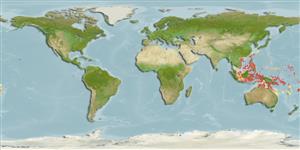>
Gobiiformes (Gobies) >
Gobiidae (Gobies) > Gobiinae
Etymology: Eviota: No etymology given, suggested by Christopher Scharpt: from Latin 'eu' for 'true' and 'iota' for anything very small, in combination 'truly very small' referring to it as being the smallest vertebrate at the time it has benn described by Jenkins (thus, making the suggestion by Scharpt plausible..
More on authors: Greenfield & Randall.
Environment: milieu / climate zone / depth range / distribution range
Sinh thái học
Biển Cùng sống ở rạn san hô; Mức độ sâu 2 - 31 m (Ref. 90102). Tropical
Western Pacific: restricted Fiji; distribution in question until further studies within the E. nigriventris complex (which this species is part of) are completed.
Bộ gần gũi / Khối lượng (Trọng lượng) / Age
Maturity: Lm ? range ? - ? cm
Max length : 1.3 cm SL con đực/không giới tính; (Ref. 87726)
Short description
Hình thái học | Sinh trắc học
Các tia vây lưng cứng (tổng cộng): 7; Các vây lưng mềm (tổng cộng): 9-10; Tia cứng vây hậu môn 1; Tia mềm vây hậu môn: 8 - 9. This species is distinguished from its congeners by the following characters: dark band on entire lower body from the head back to the caudal-fin base where it intensifies and ends in a semi-circle; pectoral-fin base with small black dots, more intense dorsally; cephalic sensory pore system lacking the PITO and IT pores and the AITO pore enlarged; dorsal/anal fin-ray formula usually 9/8; pectoral-fin rays simple; spinous dorsal elongate or filamentous in both sexes; genital papilla nonfimbriate; in life dorsal half of body yellowish cream in color, ventral half dark gray to black in type material, varying to dark reddish in others (Ref. 87726); characterized further by longitudinal scale series 23-24; ctenoid scales except cycloid on breast, none on head, nape and pectoral fin base; separated pelvic fins, bases joins by thin membrane; well developed fifth pelvic ray; depth of body 3.5-5.1 in SL (Ref. 90102).
Forms groups among branches of Acropora coral, inhabits in sheltered reefs in 2-31 m (Ref 90102).
Life cycle and mating behavior
Chín muồi sinh dục | Sự tái sinh sản | Đẻ trứng | Các trứng | Sự sinh sản | Ấu trùng
Greenfield, D.W. and J.E. Randall, 2011. Two new Indo-Pacific species in the Eviota nigriventris complex (Teleostei: Gobiidae). Zootaxa 2997:54-66. (Ref. 87726)
IUCN Red List Status (Ref. 130435)
Threat to humans
Harmless
Human uses
Thêm thông tin
Age/SizeSự sinh trưởngLength-weightLength-lengthLength-frequenciesSinh trắc họcHình thái họcẤu trùngSự biến động ấu trùngBổ xungSự phong phúBRUVS
Các tài liệu tham khảoNuôi trồng thủy sảnTổng quan nuôi trồng thủy sảnCác giốngDi truyềnElectrophoresesDi sảnCác bệnhChế biếnNutrientsMass conversion
Các công cụ
Special reports
Download XML
Các nguồn internet
Estimates based on models
Preferred temperature (Ref.
123201): 26.1 - 29.5, mean 28.2 °C (based on 635 cells).
Phylogenetic diversity index (Ref.
82804): PD
50 = 0.5000 [Uniqueness, from 0.5 = low to 2.0 = high].
Bayesian length-weight: a=0.00708 (0.00333 - 0.01504), b=3.09 (2.92 - 3.26), in cm total length, based on LWR estimates for this (Sub)family-body shape (Ref.
93245).
Mức dinh dưỡng (Ref.
69278): 3.0 ±0.3 se; based on size and trophs of closest relatives
Fishing Vulnerability (Ref.
59153): Low vulnerability (10 of 100).
